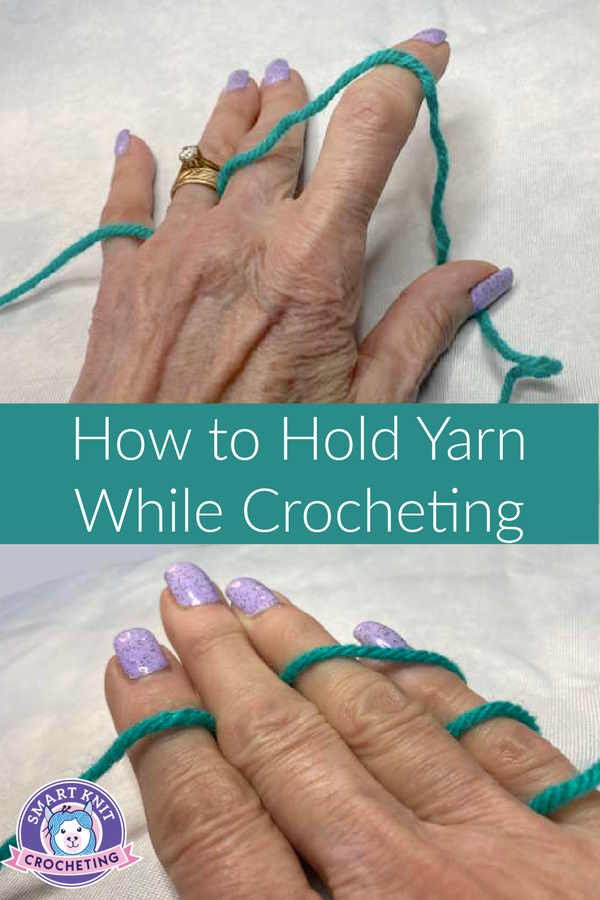- Home
- How to Crochet
- Holding Yarn While Crocheting
A Comprehensive Guide to Holding Yarn While Crocheting - What Works Best?
Holding Yarn While Crocheting by Janice Jones
Crocheting is a gratifying hobby, and it's one that many of us enjoy picking up. Whether you're a beginner or an experienced crocheter, it's essential to know how to hold the yarn correctly - otherwise, you won't be able to make the stitches you need to create your project neatly.
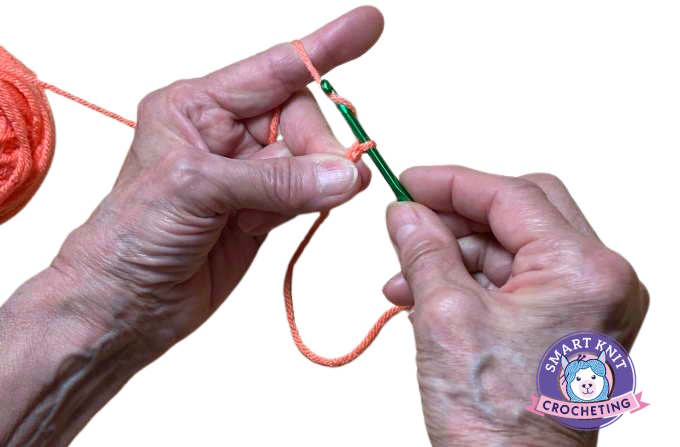
Here, we'll provide a comprehensive guide to holding yarn while crocheting, so you can crochet quickly and confidently. We'll explore the techniques available for holding and wrapping the yarn around your fingers and how it differs if you are left-handed or right-handed.
So, if you've been struggling to get your yarn to cooperate or aren't sure which technique is best for you, this guide will help you figure it out.
Why Worry About How You Hold the Yarn?
Even as beginners, we know it’s important to hold the yarn properly, but do you know why?
For starters, we want the fabric that we create with each stitch needs to look pretty, uniform, and neatly made. By that, I mean that we don’t want one stitch to look loose and sloppy and the next tight.
They all should be even and when the stitches are even, so are the edges. This is called tension.
What is Tension?
Tension consists of the pressure we place on the yarn as it flows through our fingers and onto the hook. If we hold it tightly, our stitches are going to be tight or loose if the yarn moves loosely. The trick is to get it to slide just right from the yarn ball through our fingers and around the hook. (Not to tight, not too loose).
This sounds easier said than done but it does happen as long as you are willing to practice. There is a thing called muscle memory and this means that with practice, you can train your brain to exert just the right tension on your fingers so your crocheting becomes neat and uniform.
We accomplish this tension by wrapping the yarn around the fingers on our non-dominant hand. Everyone does this a little differently and when just starting out, it’s not a bad idea to experiment with different ways to hold the yarn. You will eventually find one that works best for you.
Tension Problems - Are You a Tight or Loose Crocheter?
If you are a loose crocheter, you will:
- Have projects that are bigger than the recommended gauge or finished size
- Your edges may not be straight – some wider than others
- You may have an issue with controlling the yarn around the hook
- The yarn may split
- The yarn may get tangled
If you are a tight crocheter:
- It may be hard to get the hook into the previous stitches
- It feels like a lot of work, just to get your yarn to pull through a stitch
- Your finished product will be smaller than the recommended pattern size and your gauge will be off
- Your hands will begin to ache after just a short while
Ways to Hold the Yarn if You are a Tight Crocheter
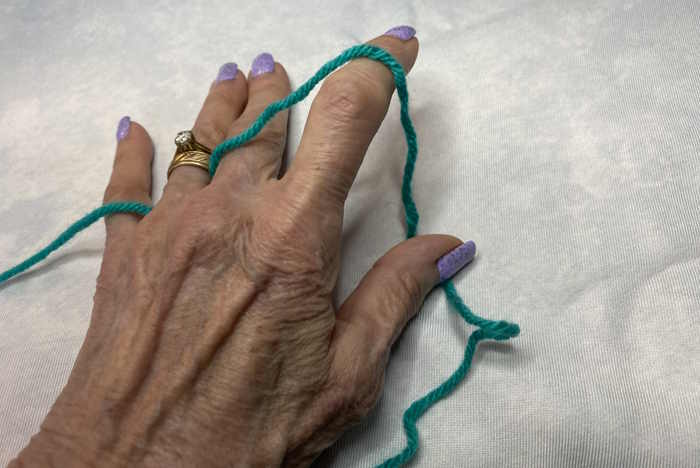 This loose hold is ideal for crocheters who tend to crochet tight.
This loose hold is ideal for crocheters who tend to crochet tight.You will want to get into the habit of holding the yarn more loosely around your fingers, to relax the tension so the stitches also become less tight. Wrap the yarn around your pinkie, under your ring and middle finger, and bring it up and over your index.
If this doesn’t relax the tension, just try wrapping the yarn over your index and control the yarn end with the palm of your hand.
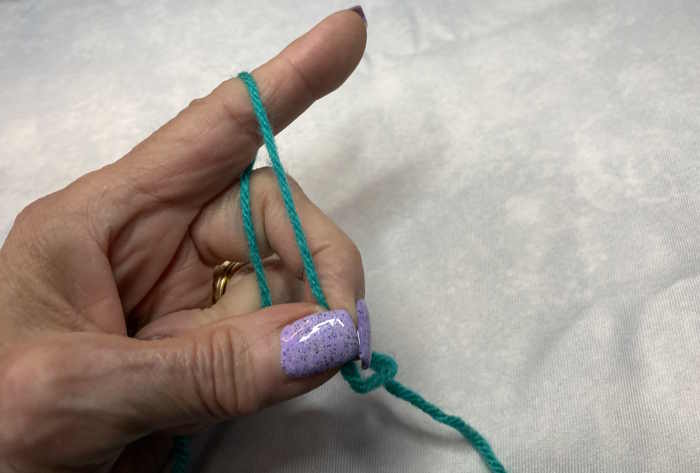
NOTE: I have seen crocheters place the yarn at the tip of the pointer finger and I’ve also seen some that control the yarn lower down on the index. Again, this is a personal preference and should not affect the tension on your yarn.
Ways to Hold Your Harn if you are a Loose Crocheter
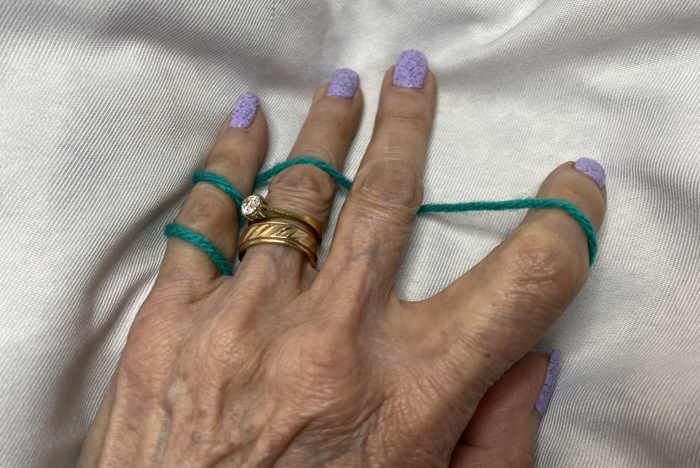 Wrap the yarn twice around your smallest finger before weaving it around your other fingers if you are a loose crocheter.
Wrap the yarn twice around your smallest finger before weaving it around your other fingers if you are a loose crocheter.Loose crocheters need to reign in on their tension by using more wraps around their fingers. One way to do this is to wrap the yarn around your pinkie finger, over your ring finger, under your middle finger, and bring it up over your index. Likewise, you can also wrap the yarn around your pinkie, under your ring finger, and over your middle and indexs.
If that method doesn’t work, you may want to try wrapping the yarn around your pinkie twice and then continue in the manner above. The more wrapping and weaving you do, the more pressure you are applying to the tension on the yarn which will make your crochet neater and less loose.
There really is no right or wrong way to hold the yarn, just what is right and comfortable for you. You will know when you have come up with the perfect hold because you will no longer need to think about it and your crochet fabric will look neat and error-free.
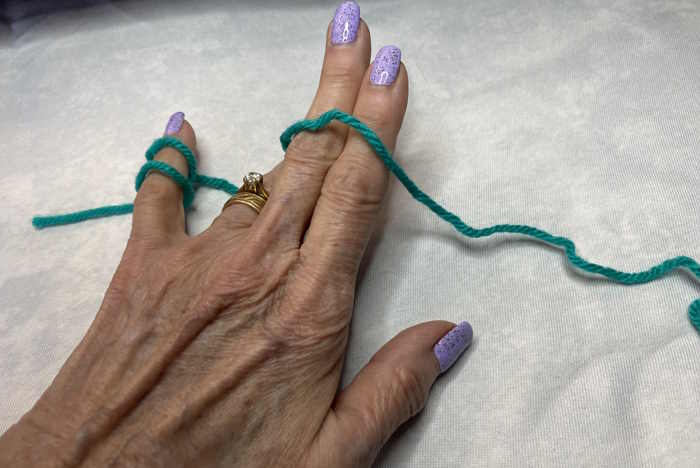 This is the same hold as the one just above, except you are holding the yarn to be worked with both your middle and index fingers.
This is the same hold as the one just above, except you are holding the yarn to be worked with both your middle and index fingers.What if Nothing Works For You When Holding Yarn While Crocheting?
It’s important to try a variety of ways of wrapping your yarn around your fingers before giving up. Most of the time, it’s just a matter of trial and error, but after awhile, you may want to throw the towel in if you feel you aren’t making any progress.
There is another solution.
You may want to consider a crochet ring to help guide and tension the yarn. Some people swear by these rings and others are not impressed. They are cheap so I don’t recommend you use them as everyday jewelry, however, you could as they are quite stylish.
The Amazon links below will provide you with a few options worth trying. As of this writing, I have not tried them, but that doesn’t mean they won’t work for you.
You may want to give them a try for crochet or even knitting if you love to knit too.
I’ve left a message board at the end of this article so I’d love to hear what solutions you have found helpful for holding and tensioning your yarn. If you used these rings, please let us know how well they work.
Right versus Left Handiness
Lucky is the person who is ambidexterious but for the rest of us, we either favor our right or left sides. We can still be master crocheters even if we are right or left handed.
We always hold the crochet hook in our dominant hand and the yarn in our non-dominant hand. The way we wrap our yarn doesn’t really matter if we are right or left-handed.

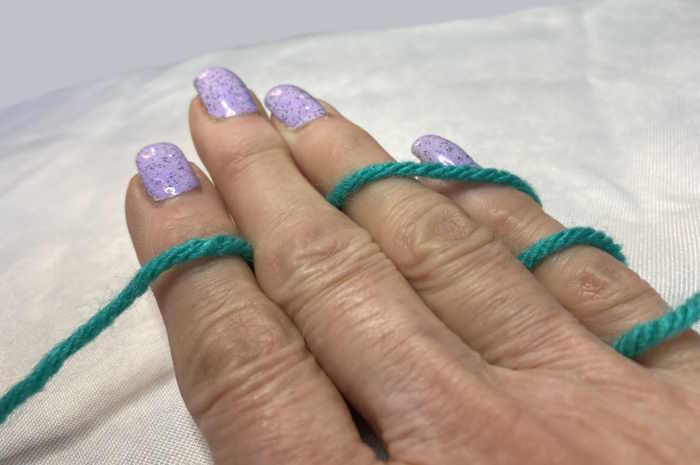
Holding yarn while crocheting is similar whether you are right or left-handed. Just remember to hold the hook with your dominant hand and the yarn with the nondominant hand.
If you are right handed, you will hold the yarn in your left hand. If you are left handed, hold the yarn in your right hand. Notice that the yarn is draped over two fingers on the left side photo and only on one finger on the right side. This is a personal preference and should not affect your tension.
Holding the Crochet Hook
There are two ways to hold the crochet hook, but as I just mentioned, you will grab the hook in your dominant hand.
The two most common ways are the pencil grip and the knife hold. To understand these two ways, think of the crochet hook as either a pencil or a steak knife.
Pencil Grip
As the name suggests, you pick up and hold the hook as if you were holding a pencil or a pen. If the hook has a thumb rest, you would place your thumb on the rest and your index on the other side. The middle finger rests near the tip of the hook.
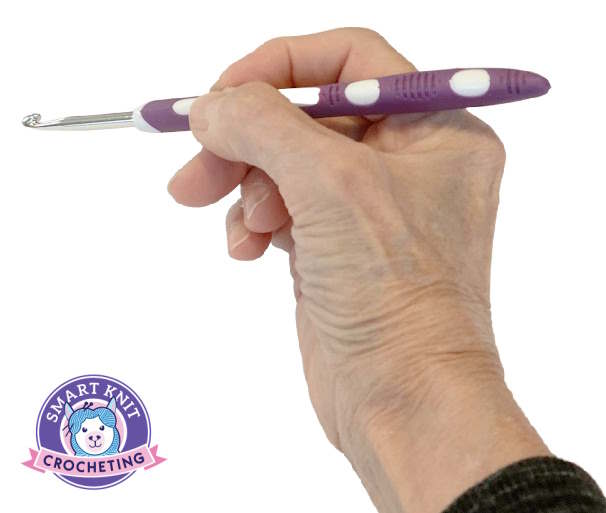 Pencil Grip
Pencil GripKnife Hold
Hold the handle of the hook in the palm of your hand and place your thumb and middle finger around and grip the thumb rest. Your index finger rests closer to the hook to guide it.
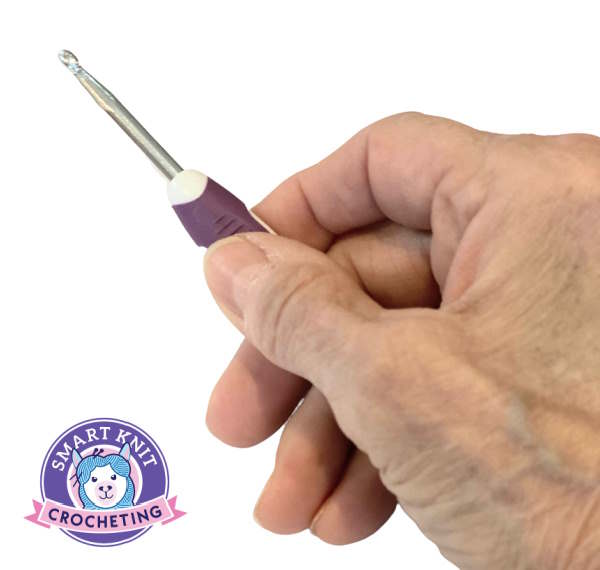 Knife Grip
Knife GripHolding Different Weights of Yarn
There is a wide range of yarn weights that we use when crocheting from a very thick cotton thread all the way up to a super bulky weight. The weight of the yarn is not the weight of the yarn ball or skein, but rather its thickness. Craft Yarn Council.
Learn more about Yarn Weights Here
Once we become comfortable with holding one weight of yarn, the way we hold the yarn is the same no matter what weight we are working with.
The same is true for holding the hook.
In the beginning, it is recommended that you start with a medium-weight yarn such as a Number 4 worsted weight. That is the easiest one to manage in my opinion.
You may also decide to try a Number 3, DK weight, or a Number 5 Bulky weight yarn. Remember to find the appropriate size of hook that corresponds to the weight of the yarn you are using.
The yarn ball provides that information or you can download this yarn weight chart for quick reference.
What to Do if Your Hands Begin to Ache When Holding the Yarn
If your hands are cramping or aching when you crochet, first stop and rest for a moment. You may be pushing your limits, especially if you have been crocheting non-stop for a long time.
Secondly, you may be gripping your hook too rigidly or tensioning your yarn to tightly. Stop and relax, try different ways to hold the hook, or re-read the above section on holding the yarn if you are a tight crocheter.
If you have any problems with joint pain or arthritis, you may want to consider a different type of hook.
My article about ergonomic crochet hooks may provide some answers and relief for sore hands.
Finally, you may want to consider a pair of tight-fitting gloves to relieve the soreness. Amazon sells a wide assortment of fingerless arthritis gloves you can use for any of your craft projects. They also work great for carpel tunnel, tendonitis, and RA.
Holding Yarn While Crocheting: Pin for Future Reference
Last Words About Holding Yarn While Crocheting
Most experts will agree that holding the yarn while crocheting is a skill like any other that requires patience and lots of practice. Until you find the method that works best for you, try experimenting with different wraps and different crochet hook holds.
Once you find one that feels comfortable to you, continue to practice until you develop that muscle memory that allows you to move onto the next level of crocheting. You will know you are there because all of your stitches are uniform and your tension is spot-on.
How do you hold your yarn? Share your opinion below.
